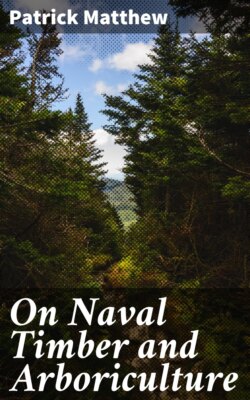Читать книгу On Naval Timber and Arboriculture - Patrick Matthew - Страница 12
ELM—Ulmus.—BROAD-LEAVED, OR SCOTCH, or WYCH ELM—Ulmus montana.
ОглавлениеThis beautiful and most graceful tree, whose favourite locality is the damp, deep, accumulated soil, free of stagnant water, at the bottom of declivities, is, together with its sister, the small-leaved kind, the English elm, when so situated, the fastest growing of our hard-wood trees. Both delight in easy or gravelly soils, though the small-leaved will also prosper in the more adhesive, the alluvial and diluvial clays.
There are a number of kinds of elm growing in this country, differing rather more from the common run of U. montana and U. campestris, than what occurs among seedling varieties of untamed plants; but as these have very probably a power of mingling by the pollen, thence not specifically different, we leave to {51} botanists to explain their nice peculiarities, and think it sufficient to rank the whole under montana and campestris, especially as the timber seems to range into two kinds—Montana, with large leaves, heavy annual shoots, somewhat zig-zag, thick towards the point, thence drooping a little from gravity; having much sap-wood, and timber of great longitudinal toughness, but, from the great quantity of sap-wood, and want of lateral adhesion, it splits considerably in drying;—Campestris, with smaller leaves, more numerous straight annual shoots, which are small towards the point, thence more erect, has but little sap-wood, and the timber also possessing greater lateral adhesion, and less longitudinal, it does not crack much in drying. We have noticed one broad leaved kind or variety, whose annual twigs often spring out in tufts or knots from one point; this seems to arise from the shoot of the preceding year sometimes dying, probably nipped by frost, and the tuft of shoots springing out from the knot at the lower extremity of the dead twig. From this cause, it has not the graceful easy spread of branches of the U. montana, but assumes a more angular, stiff, upright figure. We have heard this named Dutch Elm, but it does not quite correspond with the elm in the parks at London said to be Dutch. We consider it a kind {52} not very nearly allied to U. montana, yet the above peculiarity of appearance may only arise from individual tenderness, and may not be accompanied by other difference of character.
The elm, more especially the broad-leaved Scotch elm, has a peculiar fan-like sloping-to-one-side spread of branches, most perceptible while young; hence the tree when grown up, has generally a slight bending in the stem, which renders it very fitting for floor-timbers of vessels, the only part of a ship, excepting bottom plank, to which it is applicable, as it soon decays above water. Its great toughness and strength, however, render it good floors.
There are some kinds of foreign elm which deserve attention. Some time ago we planted several of these, and lately cut down one of about six inches diameter, which we found a great deal harder and stronger timber than our U. montana. We had this kind under the name of the Broad-leaved American. The bark was rather lighter in colour, and smoother, than U. montana; the leaves were rough and large, and the annual shoots extremely luxuriant; but, probably owing to climate, or difference of circumstance, the exposed situation where we had it growing being very unlike the close American forest, it did not carry up its vigour of growing into {53} the top, although the top was healthy, but continued throwing out numerous annual shoots, five or six feet long, from the bulb and side of stem, which disposition we did not succeed in correcting by pruning. This did not seem to arise from grafting, as some of the shoots broke out higher up than the graft must have been, and there was no difference between the lower and upper shoots.
U. montana, when come to some size, on the primary branches being lopped off, like the oak, often throws out a brush of twigs from the stem, and these twigs impeding the transit of the sap, the brush increases, and the stem thickens considerably, in consequence of a warty-like deposit of wood forming at the root of the twigs. This excrescence, when of size, after being carefully seasoned in some cool moist place, such as the north re-entering angle of a building, exposed to the chipping from the roof, forms a richer veneer for cabinet-work than any other timber. This disposition to form brush and excrescence might be given by art to almost any kind of tree, excepting the coniferæ and beech, and might be made a source of considerable profit. This could easily be effected by slitting, pricking, and bruising the bark at certain periods of the season. A very beautiful waved timber might also be formed by {54} twisting the stems of trees tight up with round ropes, the screw circles of the rope not being quite close to each other; the ropes to remain several seasons, then to be kept off for a season or two, and again applied. The practice of forming warty excrescences might be combined with that of forming wavy fibres, with the finest effect. Of course, those trees with timber of rich colour, and susceptible of high polish, would be the most suitable for undergoing this process. U. campestris also throws out a brush, but from the great inferiority of the timber in beauty, and from its unfitness for cabinet-work, it would be useless to encourage it by art. Some plants of montana, not covered with brush, have a curious unevenness (laced appearance) of the timber in the stem, which renders it a beautiful cabinet plank.
